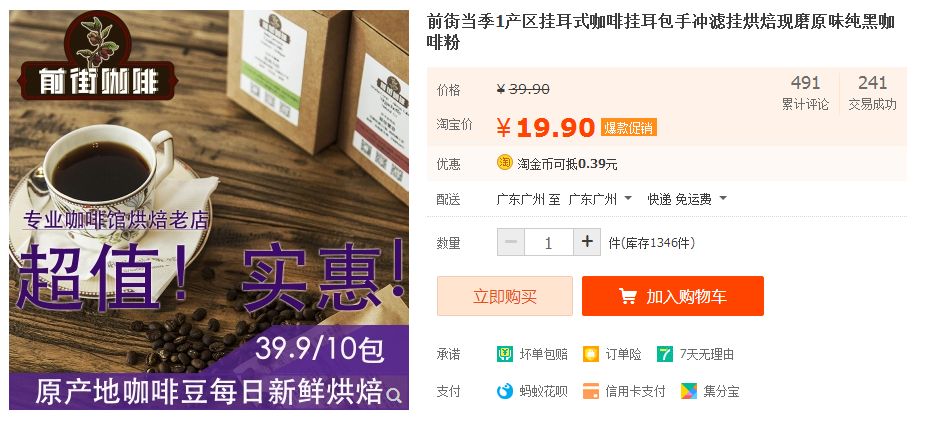Yum China 2018 results: KFC Coffee and desserts help CoffiiJoy layout multiple stores

Professional coffee knowledge exchange more coffee bean information please follow the coffee workshop (Wechat official account cafe_style)
Yum China, China's largest catering operator, announced its results for the fourth quarter and full year of 2018. Excluding foreign currency translation differences, Yum's fourth-quarter revenue was $1.91 billion, up 7% year-on-year and system sales up 6% year-on-year. Operating profit rose 84 per cent year-on-year to $84 million, both above analysts' expectations.
"regardless of the exchange rate, we achieved 6 per cent system sales growth in the fourth quarter, the ninth consecutive quarter of system sales growth since the split," said Joey Wat, chief executive of Yum China. "this strong growth benefited from the accelerated opening of new stores and the strong performance of KFC. KFC achieved a 3% increase in same-store sales and a 9% increase in system sales in the quarter. Pizza Hut sales are still weak this quarter, but we are pleased to see a 1% increase in Pizza Hut same-store traffic and a positive customer response. "
"We aggressively expanded our territory in 2018, opening 819 new restaurants in all cities, consolidating our market position and laying a solid foundation for long-term growth. Although the macro environment is relatively weak, with our resilient business model and our leadership in digital and takeout businesses, we are confident that we can maintain our growth momentum through the right strategy and capability. and profit from the long-term potential of the Chinese market. " Ms. qu Cuirong further added.
According to the National Bureau of Statistics, the growth rate of total retail sales of consumer goods continued to slow in 2018, showing the first single-digit growth since 2004. Yum China, not bogged down by the downturn in the catering industry, has expanded at an alarming rate, opening more than 800 restaurants in 2018, an average of more than two a day, the second highest annual increase in Yum's Chinese history. By the end of 2018, Yum China had more than 8400 restaurants in more than 1200 cities.
In terms of digital business, Yum China continues to focus on the seamless docking of online platforms and offline restaurants, constantly expanding the digital ecosystem and strengthening interaction with customers in every aspect of the consumer experience.
By the end of 2018, KFC and Pizza Hut had a combined membership of more than 180 million. During the annual "Singles Day" and "double Twelve" events, KFC and Pizza Hut both performed well, and GMV ranked first in Tmall and WOM food service category, respectively, successfully driving the brand's incremental sales. In December, Pizza Hut launched a family respect card to attract its core consumer group, represented by the family, and the membership program brought a significant increase in consumption frequency to the brand during the trial period. These measures reflect the great potential of online and offline integrated marketing in Yum China and its strong ability to transform digital business. With a large membership base, an extensive digital ecosystem and a large amount of transaction data, brands have a deep understanding of their customers and will continue to look for new opportunities to transform these insights.
The takeout business remains a key sales growth point for Yum China, helping the company better cater to the changing dining habits of Chinese consumers. According to qu Cuirong, Yum China adopts a hybrid takeout strategy: obtaining orders through a third-party platform and delivering food through its own riders. This strategy not only helps brands to obtain traffic from third-party platforms, but also ensures delivery quality and solves the stability of delivery during peak dining periods, especially during the Spring Festival. After nearly two years of integration, Yum China announced that it had completed the integration of leisure restaurant and home express delivery business in December. Clearer brand positioning and better marketing and operational efficiency have begun to show advantages. By the end of last year, all Pizza Hut takeout orders had been transferred to its own riders, compared with 55 per cent of self-delivery orders disclosed in the third quarter. In addition, Pizza Hut also borrows from KFC to launch a take-out premium program. The program successfully helped the two brands obtain higher frequency of premium member takeout orders. At present, Yum China's takeout business has covered 1118 cities across the country, accounting for 19% of the company's sales in this quarter.
"the significant increase in the company's operating profit in the fourth quarter is due to our strong sales growth and strict cost control in all aspects of the business. At the same time, we honor our commitment to improve investor returns by rebating $473 million to shareholders in 2018 through share buybacks and cash dividends, including $191 million in the quarter. " "looking ahead to 2019, we are well prepared for potential market weakness," said Jacky Lo, Yum's chief financial officer in China. In view of the company's excellent performance in the first three Lunar New year periods, we believe that it will be difficult to catch up in the first quarter of 2019. "
In the face of the uncertainty of the economic situation and the increasingly fierce competition in the domestic market, KFC promotes same-store sales by driving a number of growth points, including launching cost-effective promotions, strengthening cross-time and cross-product products, and so on. KFC launched the "Crazy Thursday" promotion in August last year, which was very popular. In order to meet customers' pursuit of cost-effective, KFC will continue its activities until the end of the fourth quarter. At the same time, KFC seized the important business opportunities of market segments and continued to expand its breakfast, coffee and dessert business. Last year, KFC sold more than 90 million cups of coffee, achieving double-digit growth and generating revenue of more than 1 billion yuan. By the end of 2018, KFC had 1110 dessert stations across the country, and dessert sales increased by more than 30 per cent in the fourth quarter. Management said that KFC has great potential in China and will invest heavily in 2019 to enhance its core competencies and will continue to open stores rapidly.
According to qu Cuirong on the performance conference call, Pizza Hut adjusted its brand positioning, and the new Pizza Hut was positioned as a family-oriented, fashionable and value-for-money leisure catering concept. Following the success of KFC's Crazy Thursday, Pizza Hut launched a "Scream Wednesday" promotion in mid-December to improve price performance and boost passenger traffic. In other areas, Pizza Hut accelerated the renovation of its stores, planned to complete all restaurant updates by 2021, and adopted a variety of store types to meet the development needs of different business locations and takeout businesses. Through a series of brand image renovation initiatives, according to consumer research feedback, Pizza Hut in the food taste, cost-effective and young and dynamic image has been a good response, especially in first-tier cities.
Notably, Little Fat Sheep, a hot pot brand owned by Yum China, opened 78 new restaurants in 2018 and now has more than 300 restaurants in more than 120 regions and cities around the world, and plans to further expand in Chinese and overseas markets. COFFii-喜悦, a newly launched independent coffee concept in Yum China, disclosed for the first time in its third-quarter results that it now has 13 stores in four cities in eastern China. Qu Cuirong said that the brand continues to test different types of stores and is very optimistic about the development potential of China's coffee consumption market.
Management says it is fully prepared for any uncertainties in the future market and will continue to drive growth through innovation, best-in-class execution, and superior services. The company plans to add 600-650 restaurants in 2019, as well as more COFFii & 喜悦 stores. Yum China is confident that it will continue to invest in its core brands and maintain its leading position in China's catering industry.
END
Important Notice :
前街咖啡 FrontStreet Coffee has moved to new addredd:
FrontStreet Coffee Address: 315,Donghua East Road,GuangZhou
Tel:020 38364473
- Prev

Front street opening ceremony! Seasonal hanging ear 19.9+ combination hanging ear 29.9+ candle flower butterfly discount
Professional coffee knowledge exchange More coffee bean information Please pay attention to coffee workshop (Weixin Official Accounts cafe_style) Happy New Year! Big fan discount! Front Street New Year Lilly ~ Hanging ears Front Street Selected single production area Hanging ears box of ten packs of a single variety 19.9 POS EXPRESS!! Copyright © 2016 - 2017 All Rights Reserved.
- Next

The Russian coffee market is growing rapidly in 2018. How much coffee do Russians drink?
Professional coffee knowledge exchange more coffee bean information Please pay attention to coffee workshop (Wechat official account cafe_style) the Russian coffee market is one of the hot drink markets, although there is great instability in the consumption sector, the Russian coffee market is showing a steady upward trend and consumption is growing. Another factor in the growth of the entire hot drink category, including coffee, in 2018 is in Russia.
Related
- Is espresso stored overnight in the refrigerator harmful to your body? Is frozen coffee better than freshly ground coffee?
- What parameters and proportions of water temperature should be used to grind and brew fresh coffee beans? Why can't I drink freshly roasted coffee right away?
- Customers have "changed" Manner's new products! Shop assistant: Please don't mess around!
- Remove sockets in customer areas at Starbucks stores?! Netizen: I won't go if I really tear it down
- What is the difference between the taste steps of sun-dried coffee and washed coffee? Why is sun-cured coffee sweeter and washed coffee sour?
- The recipe for salty grapefruit dirty is revealed! Coffee Festival salty grapefruit dirty coffee making materials parameters ratio milk share!
- How about the flavor of Sunlight 74158 at Sidamo Banshaha Mathieu Processing Factory in Ethiopia? 74158 Share the proportion of coffee brewing parameters!
- What effect does Italian American coffee with filter paper have? Will coffee taste better if it is put on filter paper at the bottom of the powder bowl?
- What is the color difference in coffee beans? What are the characteristics of honey processed coffee beans? Why are the anaerobically treated coffee beans uneven in color?
- How does novice Xiaobai quickly get started and make coffee? Newbies learn to make coffee by hand and share the specific steps and process process!

